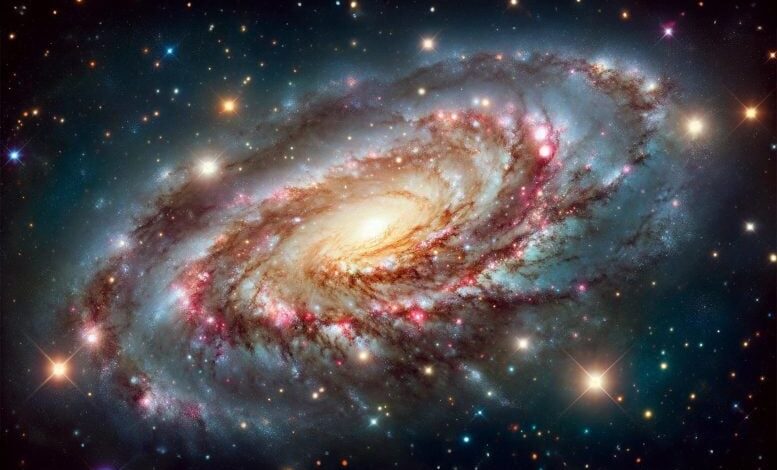Cosmic History Rewritten With New Webb Telescope Discoveries


New results from the James Webb Space Telescope show that spiral galaxies were prevalent just 2 billion years after the universe formed, indicating a faster timeline for galaxy development. Credit: SciTechDaily.com
Astronomers have revealed that spiral galaxies appeared more frequently in the early universe than previously believed, based on new findings using NASA’s James Webb Space Telescope. This challenges earlier notions of galaxy formation timelines and suggests that galaxy development occurred faster than assumed.
Scientists at the University of Missouri are peering into the past and uncovering new clues about the early universe. Since light takes a long time to travel through space, they are now able to see how galaxies looked billions of years ago.
In a new study, the Mizzou researchers have discovered that spiral galaxies were more common in the early universe than previously thought.
“Scientists formerly believed most spiral galaxies developed around 6 to 7 billion years after the universe formed,” said Yicheng Guo, an associate professor in Mizzou’s Department of Physics and Astronomy and co-author on the study. “However, our study shows spiral galaxies were already prevalent as early as 2 billion years afterward. This means galaxy formation happened more rapidly than we previously thought.”

Vicki Kuhn, a graduate student in Mizzou’s Department of Physics and Astronomy, led the study. Kuhn’s passion for studying astronomy began during high school. Credit: Sam O’Keefe / University of Missouri
Understanding Spiral Galaxy Formation
This insight could help scientists develop a better understanding of how spiral galaxies such as the Milky Way, Earth’s home galaxy, formed over time.
“Knowing when spiral galaxies formed in the universe has been a popular question in astronomy because it helps us understand the evolution and history of the cosmos,” said Vicki Kuhn, a graduate student in Mizzou’s Department of Physics and Astronomy who led the study. “Many theoretical ideas exist about how spiral arms are formed, but the formation mechanisms can vary amongst different types of spiral galaxies. This new information helps us better match the physical properties of galaxies with theories — creating a more comprehensive cosmic timeline.”
Enhancing Knowledge With Advanced Technology
Using recent images from NASA’s James Webb Space Telescope (JWST), the scientists found that nearly 30% of galaxies have a spiral structure about 2 billion years after the universe formed. The discovery provides a significant update to the universe’s origin story as previously told using data from NASA’s Hubble Space Telescope.
Studying distant galaxies with JWST gives Guo, Kuhn and other scientists an opportunity to solve a cosmic puzzle by determining the meaning of each clue.
“Using advanced instruments such as JWST allows us to study more distant galaxies with greater detail than ever before,” Guo said. “A galaxy’s spiral arms are a fundamental feature used by astronomers to categorize galaxies and understand how they form over time. Even though we still have many questions about the universe’s past, analyzing this data helps us uncover additional clues and deepens our understanding of the physics that shaped the nature of our universe.”
Reference: “JWST Reveals a Surprisingly High Fraction of Galaxies Being Spiral-like at 0.5 ≤ z ≤ 4” by Vicki Kuhn, Yicheng Guo, Alec Martin, Julianna Bayless, Ellie Gates and AJ Puleo, 11 June 2024, The Astrophysical Journal Letters.
DOI: 10.3847/2041-8213/ad43eb
Additional co-authors are Alec Martin, Julianna Bayless, Ellie Gates and AJ Puleo. This project was supported by University of Missouri Research Council grants and the Missouri Space Grant Consortium.
This study was presented by Kuhn at the 244th meeting of the American Astronomical Society in Madison, Wisconsin.



